How to Do Business Research in Less than 30 Minutes?
Table of contents
Standard company surveys last from 6 to 12 months. Of course, their length depends on whether they are surveys or quantitative research, company resources, money, and employee time and energy.
Business research involves establishing a brand’s position in the market. It involves gathering and analyzing information about the market situation, target audience, and competitors.
This research is key to understanding a brand’s strengths, weaknesses, opportunities, and threats. It helps shape strategies that can increase productivity, customer loyalty, and brand recognition.
I’ve got good news!
Market research doesn’t have to take that long anymore.
You can use AI tools without losing the quality of the results. The tool makes it easy to collect data, conduct market research, gain insights and even analyze customer satisfaction.
Check out how to incorporate AI into your daily behavior to take market research to the next level!
Try the best business research tool!
What is Business research?
Business research is the process of collecting and analyzing data to assist companies in making better-informed decisions. It covers various topics, including user satisfaction, competitive analysis, market trends, and internal business operations.
Various research methods, such as surveys, interviews and focus groups, can be used to understand consumer behavior.
They help identify patterns and motivations. Further, they provide insight into the market situation and needs, as well as the target market.
Take a look at this case study:
Through in-depth business research in 2002, Heinz identified key consumer frustrations: difficulty getting ketchup out, sloppy dispensing, and wasted product.
Identifying the problem and consumer needs, led them to create the squeeze bottle.
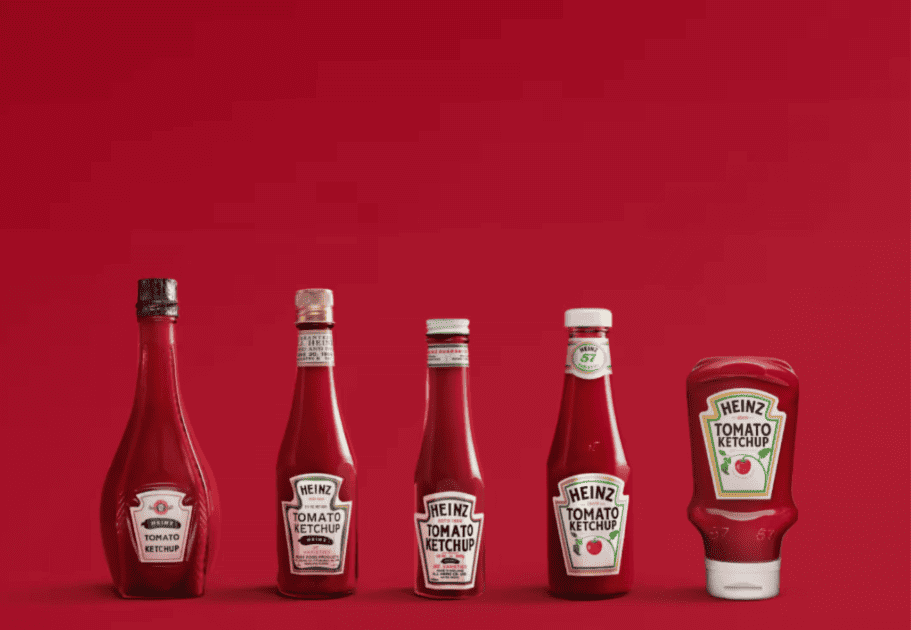
That was a huge, successful step for them! Heinz increased sales and set new industry standards.
Understanding the market situation and consumer feedback is key to staying competitive, building brand loyalty, and adapting to market changes.
Business research goals and benefits
- Audience research: Understanding customer needs, preferences, and satisfaction levels
- Market analysis: Assessing market potential and market situation
- Competitor research: Analysis of strategy and positioning, assessment of market saturation
- Marketing action evaluation: optimizing marketing campaigns based on comparison with data
- Exploratory research: Identification of new market opportunities and trends to reach new potential customers
- Evaluation: Research for product development and innovation but also risk analysis
Try the best business research tool!
How to do Business research?
Business research may seem like a long task, but what if I told you that it can be done in less than 30 minutes? Yes, it is possible!
The secret is to use smart marketing research techniques.
Here’s a quick overview of the two main types of market research based on data sources:
- Primary Research: This involves collecting your original data through surveys and interviews. Create new insights from the beginning.
- Secondary Research: This type relies on existing research that someone else has already gathered. It’s a great way to back up findings without wasting time checking what already exists.
There are also two types of market research based on the depth and detail of information:
- Qualitative Research: Focus on a small sample size to get in-depth information into consumer preferences. It’s all about understanding the “why” behind behaviors.
- Quantitative Research: Gathering and analyzing large datasets to gain a broader overview of consumer markets. It’s useful for creating focus groups that accurately reflect the customer base.
Ready to dive into market research in just three steps? Let’s go!
Step 1: Ask AI tools
Choose from several solutions depending on the depth of insight you need into your research.
Top AI tools for Business Research:
- Chat GPT
- Perplexity
- Brand24
What is the difference between them?
ChatGPT
ChatGPT provides general responses based on its training data and online insights. It’s perfect for secondary market research, helping gather information quickly.
However, remember that it primarily relies on search engine data, which may not fully capture sentiment or brand perception.
Perplexity
Perplexity bases answer accuracy and up-to-date information, sourcing answers from online content. This focus helps minimize inaccurate or outdated responses, making it a solid choice for secondary research.
While it provides valuable insights, it, too, may miss insights into public sentiment.
Brand24
Brand24 collects information like ChatGPT and includes data from your monitoring projects. Thus, responses are based on the collected information about your audience. This allows you to focus on your audience and understand their behavioral patterns and sentiment.
This insight can help you refine your strategies, identify new opportunities and build on your goals.
After this year’s Formula Red Bull season is quite loud, I have decided to research it using a ChatGPT and Perplexity. Let’s check what they are gonna tell!
What is the sentiment around the Red Bull brand?
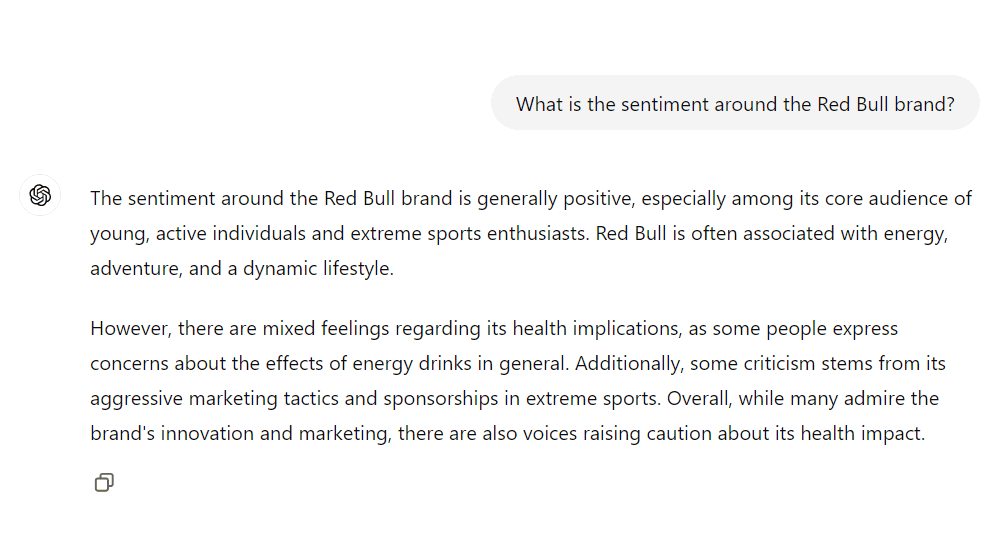
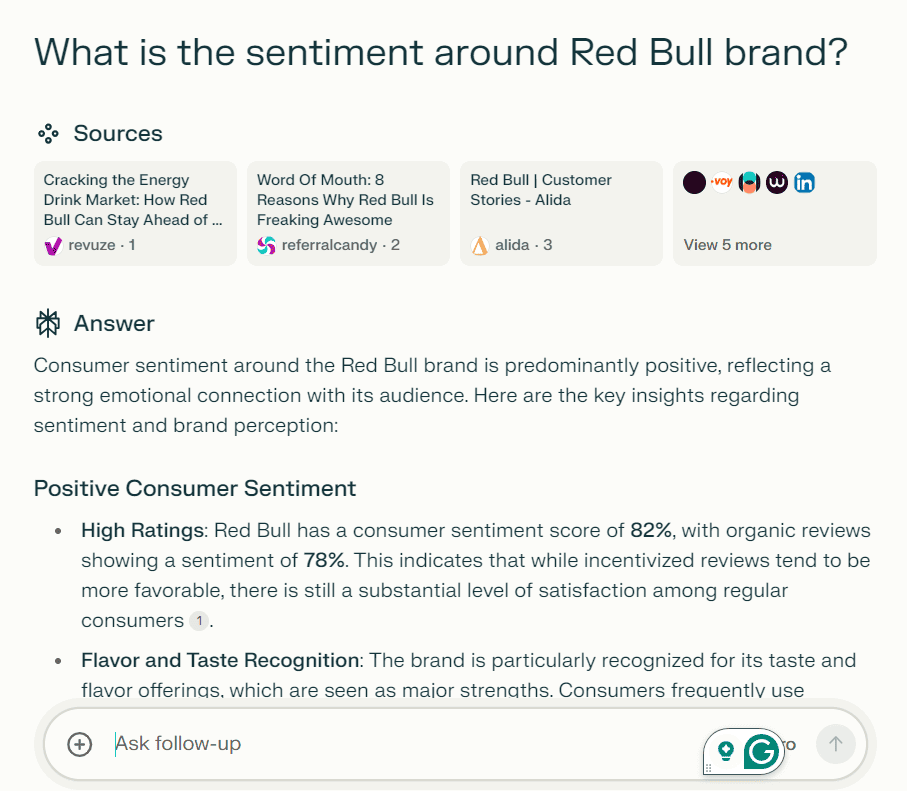
Those are correct but very generic answers.
While conducting research, it is necessary to gain deeper knowledge of the topic. No overall information is available to any online user, like the information provided by Chat GPT and Perplexity.
This means it needed a tool to conduct primary research and provide new information about the market based on internal data.
Let’s check what Brand24 Assistant is going to answer!
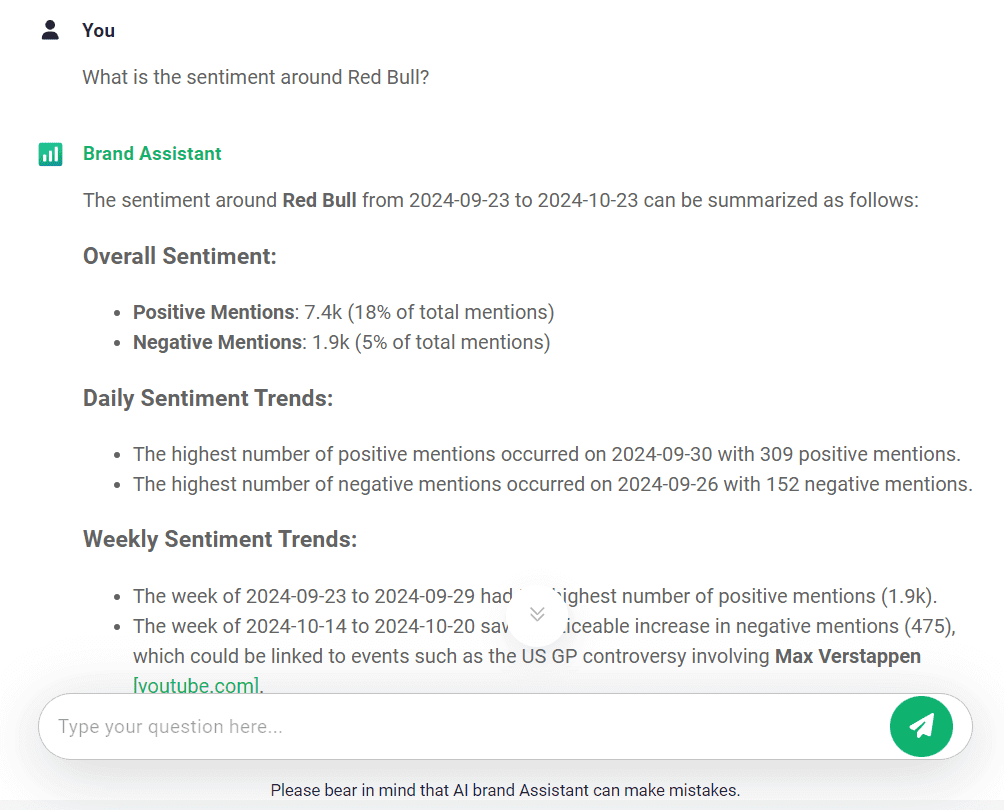
There is a difference in the figures, isn’t there?
Only the brand assistant pointed out the situation about Formula 1 and Max Verstappen.
Impressive!
AI Brand Assistant supports its answers with its quantitative research results. This ensures that its answers are precise and timely and reflect the sentiment analysis and the actual state of your brand online.
You can also ask follow-up questions.
Let’s check what do customers think of Max Verstappen’s leaving Red Bull?
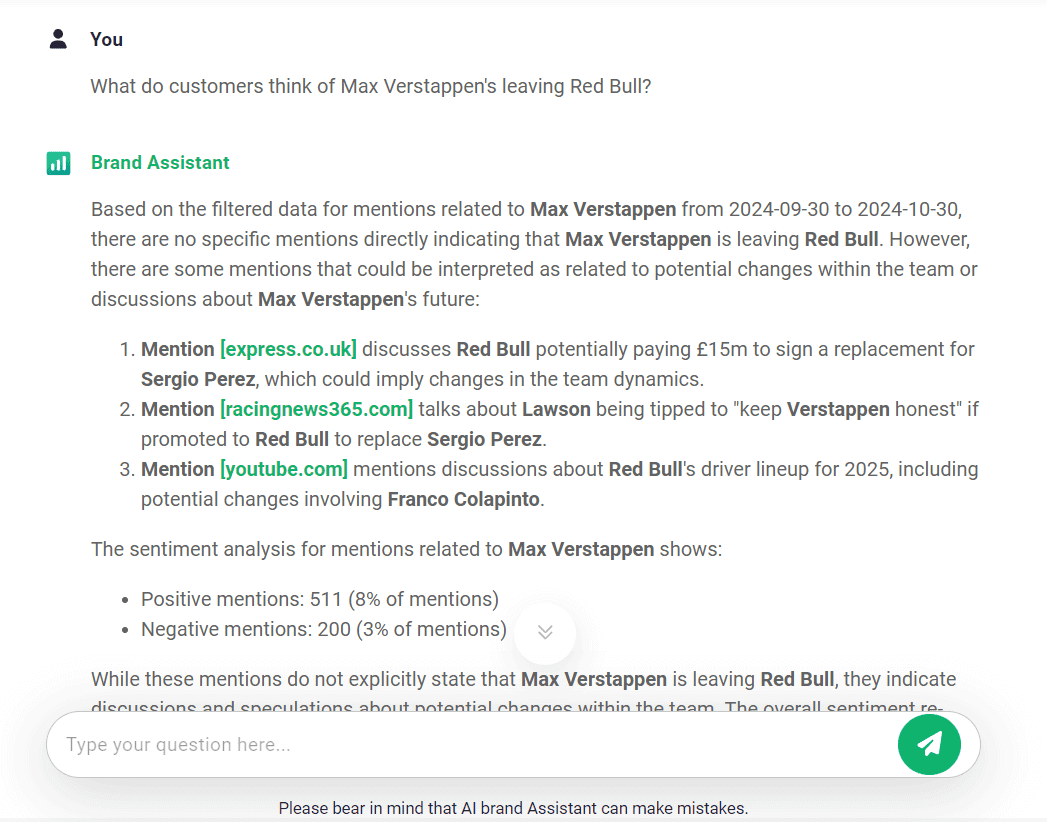
As you can see, it’s easy to find that Red Bull is now facing a potential PR crisis including fan reaction if changes to the team do not lead to better results or disrupt the team.
Even if the answer to a question needs detailed information, Brand24 can handle it. From the mentions collected by the target audience over time.
This in-depth knowledge helps make business decisions, improve marketing strategies and prevent PR crises. It also allows you to respond to customer needs and pain points.
Some examples of questions and prompts you can ask:
- What is the primary source of mentions?
- How many mentions did the brand receive in the last 30 days?
- What other brands appear in mentions?
- How do customers feel about the product/brand/company?
- What are the latest trends for the product/brand/company?
- What is the most trending topic?
- What is the most mentioned product?
- What time the target audience is most active on Instagram?
- How do customers perceive [Brand’s 1 name] compared to [Brand’s 2 name]?
- What is the share of voice compared to [Brand name]?
- Conduct competitor analysis of [Brand name].
- Conduct sentiment analysis of [Brand name].
- Present customer insights.
Ask the Brand Assistant! He knows the answer!
Step 2: Ask the target audience
Next, it’s time to go directly to the target group.
If you want to gain deeper insights, talking with the people you targeted is crucial.
A few methods can be helpful, such as online surveys, interviews, or focus groups. Those methods provide valuable information and allow you to build solid relationships with them.
Let’s check a few tips on how to start with surveys and interviews:
- Do not hint: During the preparation stage, make sure that the form of the questions does not suggest an answer.
- Be clear: Make sure your questions are understandable and answer the information you seek. A good habit for this is to create a control group and see how people respond.
- Be ready for the process: The best way to get a full picture of the situation is to make a survey, interview and focus group.
- Be flexible: Moderate the flow of the conversation, probe deeper with participants, and add extra questions if you think they might provide valuable points.
The research stage is time-consuming but can help target strategy in a good direction. Focus on customers and stand out in the market.
Step 3: Benchmark with competitor
The last step of business research!
When all points are collected, the results of the whole process are also ready.
It’s time to get closer to the industry situation. This step will show where the company stands in the market.
Benchmark your business research data against a similar brand, product, or company.
This step will uncover competitive advantages, improvement opportunities, and areas where your company already shines.
How to benchmark with competitors?
Simple ways are always the best ones. Thus, competitor analysis tools like Brand24’s Comparison tab should be used. It directly compares key metrics like:
- Mentions
- Sentiment
- Social Media Reach
- Non-social Reach
- Online Presence Score
- Advertising Value Equivalency (AVE)
- User-Generated Content (UGC)
- Share of Voice
Discover where competitors are performing well and where they have gaps, giving a clear picture of the competitive scope.
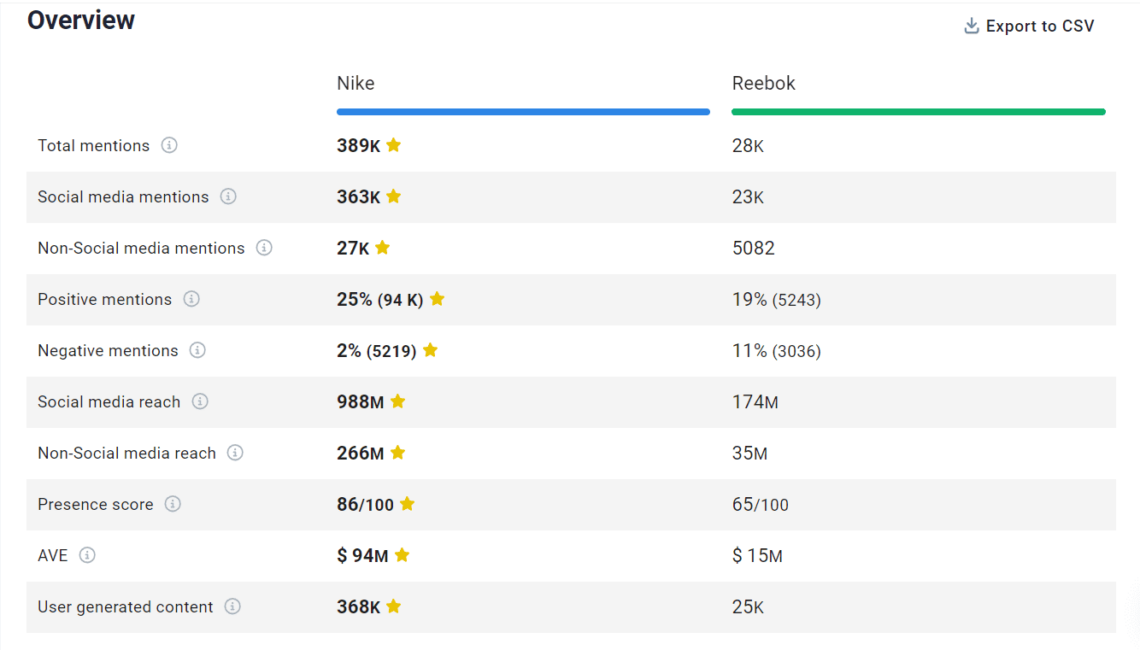
It’s not necessary to analyze the data by yourself; ask our Brand Assistant:
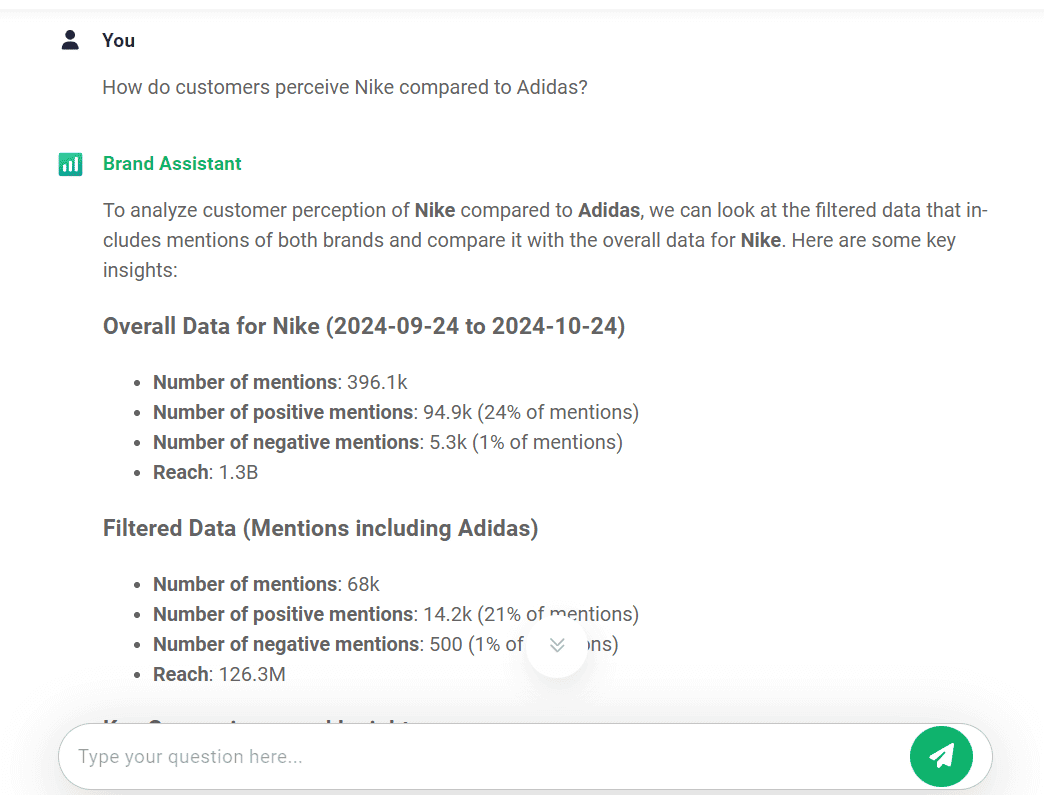
Simply Brand Assistant can answer any company question, based on collected internal information.
Let’s check how is going to ask for more open questions:
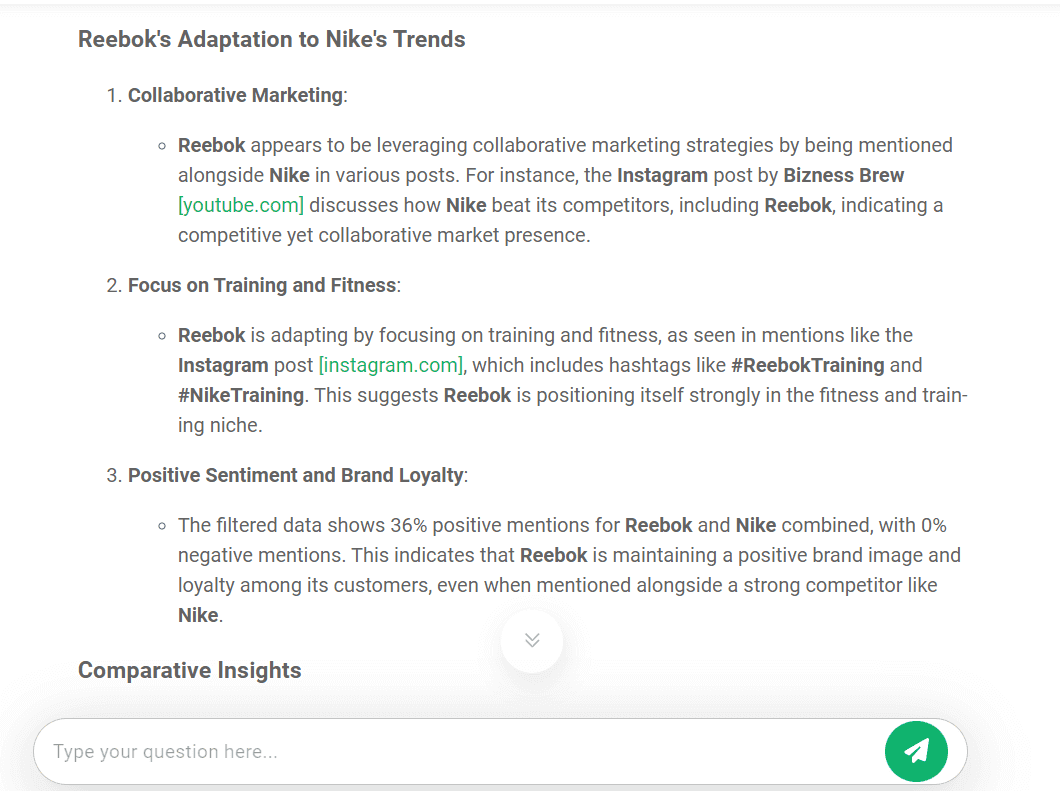
Ask the Brand Assistant! He knows your competitors!
Challenges in business research
During market research, you may face several key challenges:
- Access to reliable data – It can be difficult to obtain accurate and trustworthy information, especially about competitors or potential customers.
- Representativeness of the sample – It’s crucial that the research group is representative to ensure the results are valid and reliable. After all, a sample of 50 people out of 50,000 users might not reflect broader trends or dependencies.
- Complexity of data analysis – Analyzing large amounts of information can be challenging and requires advanced analytical skills or a professional researcher. This is why it’s helpful to rely on specialized tools, such as research processes and software.
- Changing market conditions – The market evolves quickly. It means that data collected at a specific time can quickly become outdated. Keep your eye out and try to avoid giving in to short-term trends or temporary changes in your company or the market.
- Limited resources and time – Gathering all the information and analyzing it takes time and resources, which can be especially difficult for smaller companies. As a researcher, you must balance the need for thorough research with the reality of time and budget constraints.
Don’t worry; proper planning and use of analytical software can successfully overcome these challenges, especially when conducting market research related to services or business performance!
It’s crucial to choose the right long-term solution that fits the situation, given the dependent variable under study.
Try the best business research tool!
Conclusion
In today’s fast-changing marketing world, effective business research is crucial to stay ahead of the game and keep up with industry trends.
I believe that using AI tools is one of the best ways to speed up the research process!
With their help, it’s easy to identify market trends, understand competitors’ strengths and weaknesses, and discover new growth opportunities, all of which contribute to brand awareness.
They provide valuable data that can help to stay ahead of the competition, adjust marketing strategies and increase brand’s market share through effective sentiment analysis.
Final thoughts:
- Business research is the key to any successful business strategy. They make it possible to become aware of the target market, help companies adapt quickly to changes and maintain a competitive edge.
- Artificial intelligence tools save time and provide precise information that manual analysis cannot match – they are essential for modern competitive analysis.
- Tools like Brand Assistant offer more than just general recommendations; they analyze detailed data in real time, perform sentiment analysis, and much more!
Ready to transform your business research process? Start your free trial with Brand24 today and see how AI-based analytics can make a difference!



